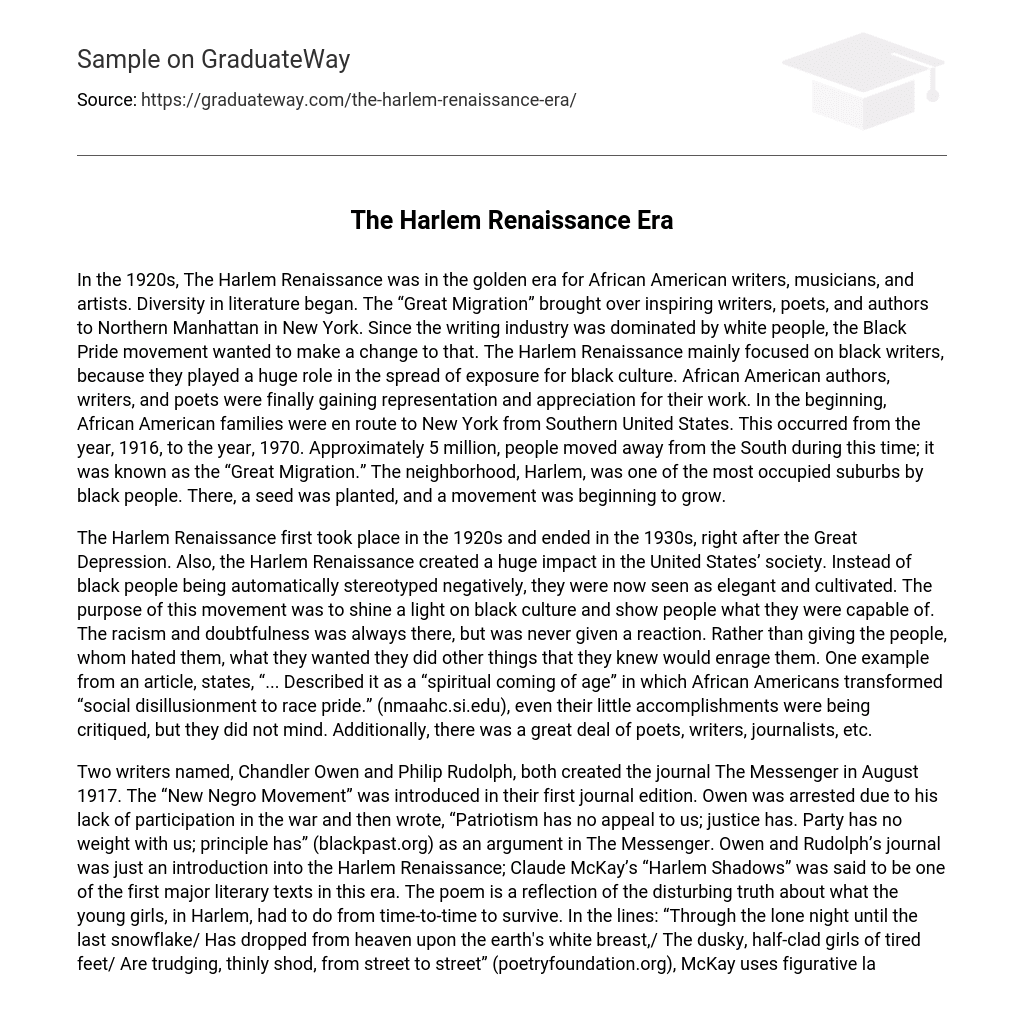In the 1920s, The Harlem Renaissance was in the golden era for African American writers, musicians, and artists. Diversity in literature began. The “Great Migration” brought over inspiring writers, poets, and authors to Northern Manhattan in New York. Since the writing industry was dominated by white people, the Black Pride movement wanted to make a change to that. The Harlem Renaissance mainly focused on black writers, because they played a huge role in the spread of exposure for black culture. African American authors, writers, and poets were finally gaining representation and appreciation for their work. In the beginning, African American families were en route to New York from Southern United States. This occurred from the year, 1916, to the year, 1970. Approximately 5 million, people moved away from the South during this time; it was known as the “Great Migration.” The neighborhood, Harlem, was one of the most occupied suburbs by black people. There, a seed was planted, and a movement was beginning to grow.
The Harlem Renaissance first took place in the 1920s and ended in the 1930s, right after the Great Depression. Also, the Harlem Renaissance created a huge impact in the United States’ society. Instead of black people being automatically stereotyped negatively, they were now seen as elegant and cultivated. The purpose of this movement was to shine a light on black culture and show people what they were capable of. The racism and doubtfulness was always there, but was never given a reaction. Rather than giving the people, whom hated them, what they wanted they did other things that they knew would enrage them. One example from an article, states, “… Described it as a “spiritual coming of age” in which African Americans transformed “social disillusionment to race pride.” (nmaahc.si.edu), even their little accomplishments were being critiqued, but they did not mind. Additionally, there was a great deal of poets, writers, journalists, etc.
Two writers named, Chandler Owen and Philip Rudolph, both created the journal The Messenger in August 1917. The “New Negro Movement” was introduced in their first journal edition. Owen was arrested due to his lack of participation in the war and then wrote, “Patriotism has no appeal to us; justice has. Party has no weight with us; principle has” (blackpast.org) as an argument in The Messenger. Owen and Rudolph’s journal was just an introduction into the Harlem Renaissance; Claude McKay’s “Harlem Shadows” was said to be one of the first major literary texts in this era. The poem is a reflection of the disturbing truth about what the young girls, in Harlem, had to do from time-to-time to survive. In the lines: “Through the lone night until the last snowflake/ Has dropped from heaven upon the earth’s white breast,/ The dusky, half-clad girls of tired feet/ Are trudging, thinly shod, from street to street” (poetryfoundation.org), McKay uses figurative language to show how these girls are suffering due to the white world (scribd.com). All in all, this was the start of African American writers receiving the credit and recognition they worked hard for, for so long.
The acknowledgement that black culture was acquiring, could have easily gone one of both ways: good or bad. It was well-known that black people were looked down upon by white people, who believed they were superior, because of their history and past. Although, they did not allow that to affect their talent and skills, and instead, used it as a way to express themselves, their thoughts, and their feelings. By using their own oppression and experiences in their writing, they opened the minds of many people.
Works Cited
- Editors, History.com. “Harlem Renaissance.” History.com, A&E Television Networks, 29 Oct. 2009, www.history.com/topics/roaring-twenties/harlem-renaissance. Accessed 14 January 2019
- Lewis, Femi. “21 Literary Achievements of the Harlem Renaissance.” Thoughtco., Dotdash, 2018, www.thoughtco.com/literary-timeline-of-harlem-renaissance-45420. Accessed 11 January 2019
- McKay, Claude. “Harlem Shadows by Claude McKay.” Poetry Foundation, Poetry Foundation, 1922, www.poetryfoundation.org/poems/44693/harlem-shadows. Accessed 10 January 2019
- Simone, Lexis. “Harlem Shadows Analysis.” Scribd, Scribd, www.scribd.com/doc/81144790/Harlem-Shadows-Analysis. Accessed 14 January 2019
- “Sterling A. Brown.” Poets.org, Academy of American Poets, 6 Oct. 2015, www.poets.org/poetsorg/poet/claude-mckay. Accessed 15 January 2019





